Total eXplore pages
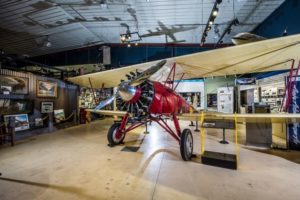 |
1928 STEARMAN C2B This aircraft was built in 1928, and arrived in Alaska in 1929. It was flown by many of Alaska’s aviation heroes, including Noel Wien, Carl Ben Eielson, Harold Gilliam, Joe Crosson, Wiley Post and Merle “Mudhole” Smith. In 1932 this plane conducted the first landing and rescue on Mt. McKinley. It was crashed in 1937, and subsequently recovered in the mid 1960s by Jack Wilson. NC5415 was restored to flying condition by Les and Janet Kares, who sold the aircraft to the Alaska Aviation Museum in 1991. |
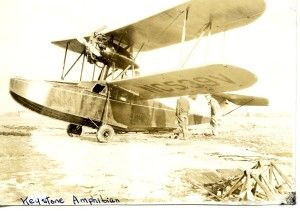 |
1929 KEYSTONE LOENING COMMUTER One of the first metal hulled amphibious aircraft, the “Commuter” was the design of Grover Loening. Loening pioneered practical amphibious aircraft designs, the last of which, the “J2F Duck”, saw service in World War II. Manufactured by the Keystone Corporation in 1929, only 40 examples were built. This is one of the last two examples in existence. Alaskan air services operated a number of Commuters as seaplanes and as land based aircraft on skis. Among the companies that operated Loenings were Gillam Airways, Alaskan Airways and Alaska Southern Airways in Juneau. This particular aircraft was brought to Alaska in 1946 by former Governor Jay Hammond. In his book The Bushrat Governor he lovingly refers to the plane as “Old Patches”. The engine blew on take-off at Shirley Lake about 100 miles northwest of Anchorage. It was abandoned there until the late 1960s when it was recovered by Anchorage citizens for the defunct Centennial Museum. The plane was transported and displayed at the Transportation Museum in Palmer and later Wasilla. It was received on loan to this Museum from the Alaska State Museum in the summer of 1993. It is believed that this aircraft carried the registration number of NC374V in that it was modified with a Pratt & Whitney 300 HP Wasp Junior engine. All other examples were powered by a Curtiss-Wright J6-9-300 power plant. The Loening Amphibian could carry four passengers and a baggage load of 50 lbs. Wings were spruce spars with aluminum ribs which were fabric covered. |
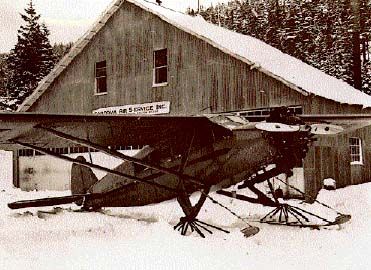 |
1929 TRAVEL AIR S6000B This aircraft model was popular as a passenger and cargo plane, being utilized by many early Alaskan operators, including Alaska Star Airlines, Woodley Airways, Alaska Coastal Airlines and Mirow Air Service. NC8159 first came to Alaska in 1939, flying for Cordova Airlines. It was subsequently sold to Jack Peck, who sold it later that year to Al Jones Airways. NC8159 was sold to the museum in 1991 by William Magnuson. |
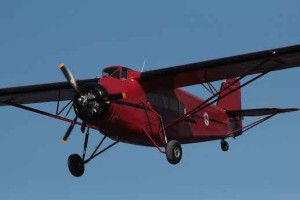 |
1931 FAIRCHILD PILGRIM 100B N709Y is one of 16 model 100A’s and the 5th 100A built by the American Aircraft & Engine Corp., formally Fairchild Co., in 1931. Originally ordered by American Airways, it was the first plane with steam heat, luggage racks and a toilet. The Pilgrim was built to carry nine passengers, with a single- seat cockpit for the pilot. It was later converted into a model 100B. Murrell W. Sasseen and Herbert Nicholson bought N709Y in August 1936 for Alaska Air Express. Later that year N709Y was sold to Star Air Service (the predecessor to Alaska Airlines) . Ball Brothers Inc., bought the aircraft in 1977 flying mostly fish as cargo out of Bristol Bay, Alaska. Due to fish slime and salt water corrosion eating away the floorboard and belly stringers, Pilgrim N709Y ceased its flying career in 1985. After the Alaska Aviation Museum acquired N709Y in 2001, the aircraft went through a decade long restoration process. Today, the Pilgrim is airworthy, and spends its summers flying throughout Alaska showcasing Alaska’s Aviation History. |
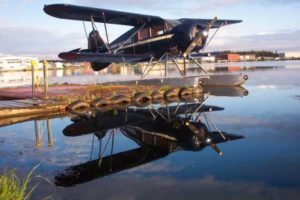 |
1934 WACO YKC S/N 3991 In 1935, the YKC became the popular YKS series that was used by many pilots companies in Alaska including Ellis Air Transport, Petersburg Air Service, and Christensen’s Flying Service. The Museum’s Waco has operated in Alaska since 1937 flying for Dillingham Air Service, Rainy Pass Lodge, and several private individuals. The last owners, Jim and Dennis Branham completely restored the aircraft. It was purchased for the Museum by Mr. and Mrs. Elmer Rasmuson of Anchorage. |
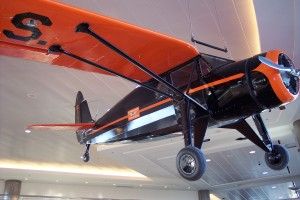 |
1938 FAIRCHILD 24G Currently on display at the Anchorage International Airport. |
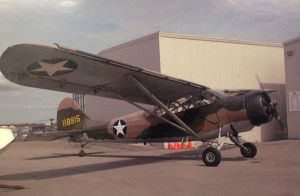 |
1941 STINSON L-1 The Stinson L-1 is a single engine high wing military observation plane that was manufactured in December 1941 and was assigned to the 11th Air Force at Fairbanks and Anchorage. It is the sole survivor of approximately 400 L-1s manufactured during WWII. It was donated to the Museum by Karl S. Johnstone in 2002. |
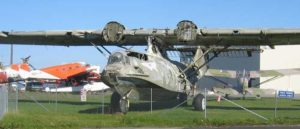 |
1943 CONSOLIDATED OA-10A PBY The Queen of Dago Lake. |
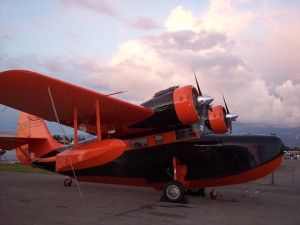 |
1943 GRUMMAN G-21A “GOOSE” The first Goose flew in 1937 and it stayed in production until 1945. Total production was 345 aircraft. During WWII the Goose served with all branches of the military and several other nations as a utility, small transport, and patrol aircraft. The Museum’s Goose, N789, was accepted by the U.S. Navy at the Grumman factory in Bethpage, NY on November 29, 1944. From there it went to various duty stations around the U.S. until 1956, when it was transferred to the U.S. Fish & Wildlife Service in Alaska. In 1974 the aircraft was reassigned to the Office of Aircraft Services which was created to provide aviation services to the Department of the Interior. In 1994, after 38 years of public service in Alaska, N789 was sold to the Alaska Aviation Museum. |
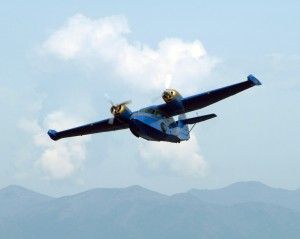 |
1943 GRUMMAN G-44 “SUPER WIDGEON” The Widgeon is the smallest member of the Grumman family of amphibious aircraft, and was intended as the smaller, less expensive alternative to the Grumman Goose. This aircraft was originally planned for civilian service, and can hold up to 5 passengers. However, Grumman quickly switched to war production for World War II and produced over 250 planes in the following years. The history of N13122 before 1967 is unknown, other than it had been registered in Canada. Neither the Grumman Aircraft Company nor the U.S. Military had this aircraft’s serial numbers on file. On March 23, 1967 the Widgeon was bought by McKinnon Enterprises in Sandy, Oregon. On July 7, 1969 the Widgeon was sold to James and Dottie Magoffin, owners of Interior Airways (which evolved into Mark Air). They used the Widgeon as their personal aircraft until it was donated to the museum in October 2001. |
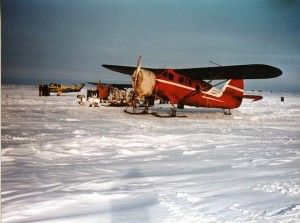 |
1943 NOORDUYN NORSEMAN The UC-64A Norseman built by Noorduyn Aviation Ltd, in Montreal Canada, first flew in 1935. The Norseman, as it was most commonly called, was the first aircraft specifically designed for operations in the arctic. It could be equipped with wheels, skis or floats and had a large, spacious fuselage that could carry a pilot and nine passengers in comfort. N725E was originally owned by the Army Air Force and used as a military transport. In 1945, this Norseman was transferred to the U.S. Fish and Wildlife Service to serve in Georgia. Northern Consolidated Airlines, operated by Ray Peterson out of Anchorage, purchased the plane in January 1950. Interior Airways used this aircraft to supply construction sites during installation of the DEW line (Distant Early Warning) defense system. Jim Magoffin, owner of Interior Airways, donated N725E to the Pioneer Air Museum in Fairbanks in 1972, which then gave the aircraft to the Alaska Aviation Museum in 1995. |
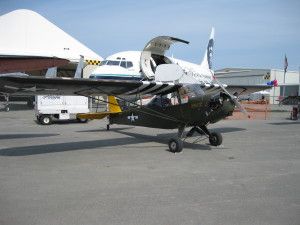 |
1943 TAYLORCRAFT L-2 The Taylorcraft L-2 Grasshopper is an observation aircraft built for the U.S. military during WWII. It has a two place, tandem cockpit and was primarily used for forward observation and artillery spotting. The aircraft was particularly good at short takeoffs and landings on unprepared landing strips. After the war, many of the aircraft were converted for civilian use as model DCO-65. The museum’s L-2, N47648, was built in 1943 and sold a year later to a civilian in Texas. The original purchase price was $946. This aircraft was purchased and transported to Alaska by Dick Benner, sold to Don Keil who then donated the aircraft to the Alaska Aviation Museum. It was named “Midge” in honor of Don Keil’s wife, a long serving volunteer at the museum. |
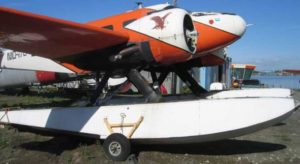 |
1944 BEECHCRAFT 18S S/N 7728 AFSN 44-4734 The Beechcraft Model or “Twin Beech”, as it was better known, first flew on January 15, 1937. It was configured to carry between 6 and 11 passengers. The aircraft was in production for 32 years, with over 9,000 aircraft being built. N1047B arrived in Juneau, Alaska in 1979. After some modifications it was sold to Alaska Coastal Airlines Corporation of Juneau in 1982. On Sept 30, 1987 N1047B was sold to the Alaska Aviation Museum and flown to its current home at the museum. The aircraft in the Alaska Aviation Museum collection is installed on Edo floats and represents the configuration the aircraft was in while assigned to the 10th Search and Rescue Squadron at Elmendorf AFB during the 1940s. |
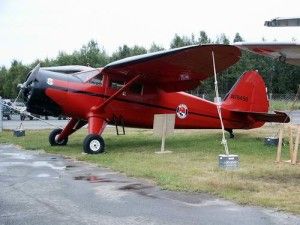 |
1944 STINSON V-77 GULLWING S/N 77-36 The Stinson Reliant, commonly known as the Gullwing, was one of the most successful designs produced by the Stinson Aircraft Corporation, with a total of 1327 being built. Introduced in 1938, it originally featured leather upholstery, walnut instrument panels, and automobile-style roll down windows. The Reliant carried a pilot and up to four passengers.The Reliant was used as a utility and trainer aircraft for the U.S. military during World War II. N79458, since being sold by the U.S. military in 1946, has had 20 separate owners prior to its arrival at the museum. By 1969 the aircraft had a complete overhaul of the air-frame and wings as well as an engine replacement. N79458 was donated to the museum by Donald Rogers and Robert Wagstaff in November 1995. |
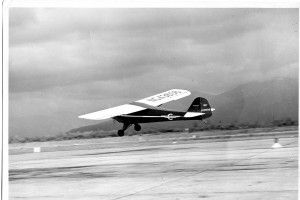 |
1946 TAYLORCRAFT BC-12D This aircraft was brought to Alaska by Jack Carr, along with two additional planes of the same model. NC43606 was flown out of the factory to Seattle, then disassembled and loaded on to a Pacific Northern Airways DC-3. Once in Alaska, NC43606 was used immediately for training pilots and charter world out of Merrill Field in Anchorage. While this aircraft had many owners, it has spent its entire career within Alaska. NC43606 was sold to the Alaska Aviation Museum in 2007 by Tyler Willis. Staff and volunteers restored this aircraft to original factory colors with the original Jack Carr logo. |
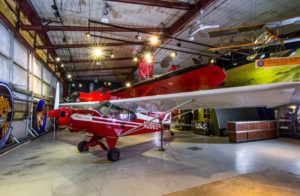 |
1955 PIPER “SUPER CUB” PA-18-150 Manufactured in 1955, N2869P is an example of a long line of tandem seated Piper Cubs. Originally designed by William Taylor as the J2 in the early 1930s, it evolved into various models; J3, J4, J5, PA11, and finally PA18. There are more than 1000 registered model PA18 aircraft in Alaska today, which attests to the popularity and longevity of the “Super Cub” design. “Super Cubs” are the principle mode of air transportation in rural Alaska due to their exceptional short takeoff/landing abilities. These aircraft are popular with both commercial guides and independent pilots. N2869P was donated to the Alaska Aviation Museum by Floyd Carlson. |
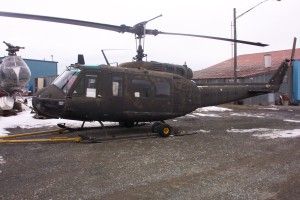 |
1963 HELICOPTER This helicopter completed three tours in Vietnam, and served with the Alaska National Guard. |
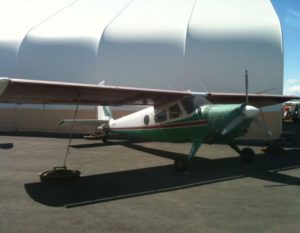 |
1966 H-295 HELIO COURIER The Helio Courier was designed in 1949 as a light C/STOL aircraft with emphasis on off-airfield operations. 500 Helio Couriers were made and manufactured in Pittsburg, Kansas from 1954 to 1974. N6919V was donated by Lowell Thomas Jr. who acquired the plane in 1969. Lowell used the plane to visit small villages throughout interior Alaska while filming for lectures about Alaska and articles for National Geographic Magazine. During the 1970s, Lowell flew around the state while campaigning for the state senate, then later for the office of lieutenant governor (as running mate of Jay Hammond). From 1979-1999 this plane, now equipped with a turbo charger, served mountain climbers in the Alaska Range, primarily off Denali. This plane also carried a number of famous people on flight seeing tours, including Walter Cronkite, arctic explorer Bernt Balchen, and Charles Lindbergh. During some 7,000 hours of flight, this plane experienced several forced landings but never a crash or any damage. N6919V was donated to the museum by Lowell Thomas Jr. in May 2010. |
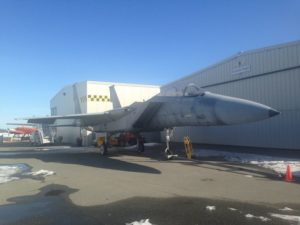 |
1974 MCDONALD DOUGLAS The F-15A Eagle is a twin-engine, high-performance, all weather superiority fighter jet. First flown in 1972, then entered the United States Air Force for service in 1974. Its air superiority is due to its advanced avionics, range and weaponry, and unprecedented maneuverability. One person can effectively perform air-to-air combat using its advanced systems to detect, acquire, track and attack enemy aircraft. The Museum received 74-0084 in June 2008 from Air Force Base Elmendorf’s 3rd Wing, continuing their great relationship with the local community. At the end of 74-0084’s career it was a Ground Instructional Training Aircraft (GITA). |